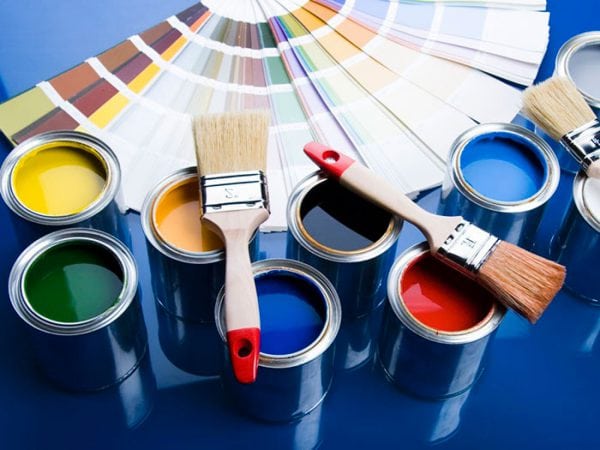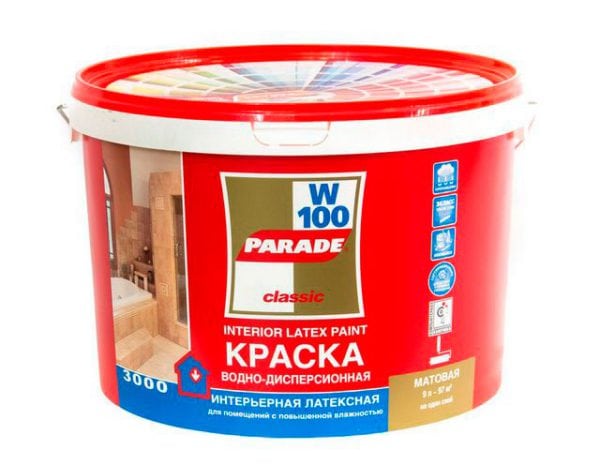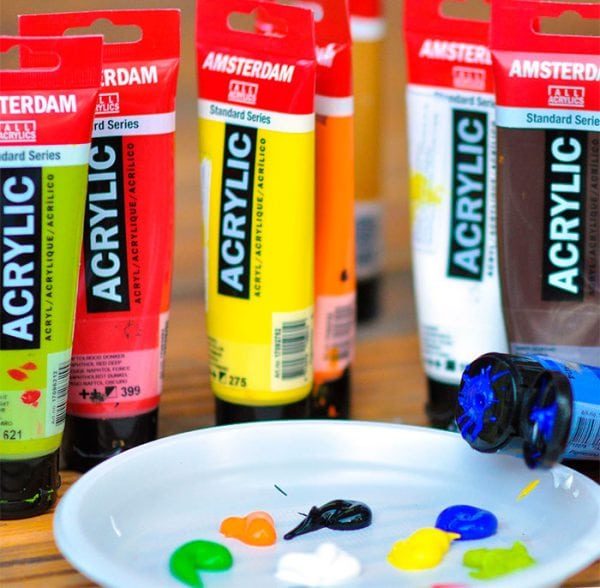In the modern production of paints and varnishes, a tendency is developing for the replacement of volatile organic solvents with water, due to their high toxicity, fire and explosion hazard. Deprived of these drawbacks, water-soluble paints are easy-to-use compositions, which, moreover, practically have no specific odor.
- Chemical composition
- Acquisition issues for interior or exterior decoration
- Advantages and disadvantages
- Where else do you need waterborne coatings?
- Instead of a conclusion


Chemical composition
If water or alcohols are used as a solvent in this product, then synthetic polymers — PVA, acrylates, styrene-butadiene and nitrile butadiene rubber — act as a bonding element. In addition, in the structure of water-borne paint mixtures there are:
- all kinds of coloring pigments in a color palette;
- hardeners - desiccants;
- plasticizers designed to give elasticity to the hardened coating and to keep the entire paint system in a homogeneous state.
Used for the decoration of walls, ceilings and other surfaces inside and outside the premises (except for the base of the floor), these mixtures are chemically aqueous dispersions of an insoluble paint composition based on a polar solvent. Requirements for the value of mass fractions of constituent elements, as well as technical characteristics, are prescribed in the national standard GOST 28196-89.
to contents ↑Acquisition issues for interior or exterior decoration
For consumers, an important feature of water-based paints is the fact that these finishing materials have an attractive cost. The exact price tag depends on what water-soluble paint is planned to be used to finish the exterior or interior walls of the building. So, the most cheap formulations based on PVA, however, it is difficult to tint. However, they are extremely unstable to abrasion and the influence of high humidity.
The intermediate position is occupied by acrylic paints, the copolymer base of which is quite tolerant to the presence of water vapor in the air, but does not tolerate drops or smudges on the painted wall.
The most expensive, but at the same time the most resistant to wear and dampness, are water-soluble latex paints. Such coatings can be washed as much as you like, but in terms of light fastness they are somewhat inferior to their acrylic competitors. If acrylic and latex painting complexes can be used for exterior work on the facade of a building, then polyvinyl acetate paints are suitable only for painting the internal surfaces of dry walls.

Recently, in the market of paints and varnishes you can find combined compositions. Due to the difference in the ratio of the percentage of latex and acrylic, the exact properties of such mixtures differ. Therefore, choosing a water-soluble paint when decorating a whole room for walls, it is necessary to compare the properties indicated on the packaging and the planned operating conditions of the paint coating.For example, for painting surfaces in dry rooms, where there is a risk of contamination of the layer, it is optimal to use materials marked “for dry rooms with low operational load”.
to contents ↑Advantages and disadvantages
Those water-soluble (acrylic, latex and PVA) paints that are used in the decorative processing of walls and other surfaces of wood, plaster, putty, brick, builders and designers are appreciated for many advantages. We list the main ones:
- The ease of application, as well as safety, when working with water dispersible paints, there is no need to protect the respiratory system of the operator, because these materials are practically odorless and their evaporation is not particularly toxic.
- The high speed of the polymerization process in air provides a short drying time for the paint coating, the exact duration of which is determined by the specific conditions on the ground (optimal: good ventilation, low or moderate humidity, temperature in the range of 22–26 degrees Celsius).
- Excellent adhesion and versatility with respect to the working surface: a cement-sand base, brickwork made of brick or gas silicate blocks, drywall and products based on it, lumber and natural wood - water-soluble color and white paints for all surfaces are ideal.
- The thin layer of the coating, good hiding power and huge selection of shades due to the good compatibility of the copolymer dispersion with the different types of pigments from which the colors are made.
- The tightness of the layer, which gives protection to the materials of walls, partitions and ceilings, from undesirable microbiological activity and corrosion processes, and also allows to increase the life of the base.
- The aesthetic attractiveness of the decorative coating, acrylic paints after hardening give a quiet fine roughness, latex form matte layers with a slight glossy sheen.
Considering the disadvantages of this product, it should be borne in mind that the polymerization process is possible only at positive temperatures.
Therefore, on packages with coloring dispersions, domestic and import manufacturers indicate a restriction - the temperature of the wall or other working base should not be below +5 degrees Celsius. In addition, in the winter it is unacceptable to store containers with paint in unheated warehouses or other rooms.
The high setting rate, due to the water or alcohol base, in water-soluble paint compositions results in the possibility of thickening the composition during storage. But due to the availability of solvents, eliminating this problem is not particularly difficult.
Water-borne coloring dispersions are widely used in the construction industry: in the initial decoration, repair or reconstruction of obsolete finishes. Allowing to mask microcracks, these paints and varnishes differ in elasticity of a layer. This quality makes them the best option when finishing wood products, because such material can change volume during operation.
to contents ↑Where else do you need waterborne coatings?
Not only in the production of building materials there is a tendency to displace organic solvents from the composition of coatings. Industrialists specializing in the supply of paints for painting, also meet the wishes of artists and produce water-soluble oil paints. These unusual compositions retained the advantages of oil-based coloring agents (flexibility, elasticity), however, they got rid of the drawbacks of classical paint caused by the presence of toxic and aggressive solvents.

The chemical composition of such products is a trade secret of manufacturers. However, from a theoretical point of view, the solubility of oils with water can be achieved if polyethylene glycol or surfactants are added to the structure. Obviously, the advantages of such products will become the reason for further developments in the production of oil suspensions diluted with ordinary water.
to contents ↑Instead of a conclusion
The modern chemical industry is actively using the properties of various polymers, and the manufacture of coatings is no exception. Recipes based on acrylic, latex, polyvinyl acetate are appreciated by consumers. Therefore, the assortment of water dispersion paints on supermarket shelves will only be replenished.



